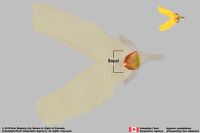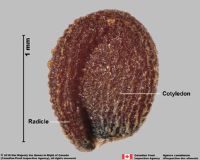Family name: Costaceae (Meisner) T. Nakai
Synonym(s): [none]
Common name(s): costus family
*Number of genera/species: 7/143
List of genera records in GRIN-Global
fruit or seed
Fruit a loculicidalloculicidal:
type of capsular dehiscence, opening longitudinally through the locules (compare septicidal)
 capsulecapsule:
capsulecapsule:
a dry, dehiscent fruit derived from a compound ovary , rarely explosively dehiscent or irregularly breaking with decay, 6–25 mm long, globoseglobose:
, rarely explosively dehiscent or irregularly breaking with decay, 6–25 mm long, globoseglobose:
3D shape—more or less spherical to trigonoustrigonous:
to trigonoustrigonous:
3D shape—having three faces that meet at distinct angles; triangular in outline
, 3-angled (triloculartrilocular:
(ovary or fruit) having three locules
) or flattened (bilocularbilocular:
(ovary or fruit) having two locules
) in transection, with stylar remnantsstyle base:
remnant of a style and often persistent sepalssepal:
and often persistent sepalssepal:
a member of the outer envelope of a flower (calyx) , with many seeds. Rarely indehiscentindehiscent:
, with many seeds. Rarely indehiscentindehiscent:
not opening on its own, as in a fruit
 . Pericarppericarp:
. Pericarppericarp:
fruit wall or fruit coat
white, red, or orange, dulldull:
reflecting only a low proportion of incident light, with no apparent sheen , woodywoody:
, woodywoody:
texture—consisting mainly of indurate lignified tissues, characteristic of or resembling wood
, glabrousglabrous:
without hairs
or pubescentpubescent:
surface relief—bearing hairs
, smooth.
Seeds globoseglobose:
3D shape—more or less spherical or polygonalpolygonal:
or polygonalpolygonal:
angular
, tereteterete:
approximately circular in cross section; width and thickness approximately equal
 in transection, 1–4 mm long. True arilsaril:
in transection, 1–4 mm long. True arilsaril:
(broad sense) appendicular structure that wholly or partly envelops a seed and is produced from or a modification of the funicle, raphe, or outer integument; usually fleshy or pulpy, sometimes spongy or tufted-capillate, often brightly colored present. ArilsAril:
present. ArilsAril:
(broad sense) appendicular structure that wholly or partly envelops a seed and is produced from or a modification of the funicle, raphe, or outer integument; usually fleshy or pulpy, sometimes spongy or tufted-capillate, often brightly colored fleshy, white or yellow, well developed and adnate to hilumhilum:
fleshy, white or yellow, well developed and adnate to hilumhilum:
on seeds, the scar indicating where the funiculus was attached; on grass caryopses, the scar visible on the outer fruit surface revealing where the seed is attached on the inner fruit wall surface; or in Asteraceae cypselae, the scar visible on the outer fruit wall revealing where the fruit was attached to the receptacle . Arilaril:
. Arilaril:
(broad sense) appendicular structure that wholly or partly envelops a seed and is produced from or a modification of the funicle, raphe, or outer integument; usually fleshy or pulpy, sometimes spongy or tufted-capillate, often brightly colored small (Monocostus, Cheilocostus), lobed (Tapeinochilos), fimbriate-laciniate (Costus, Chamaecostus), cushion like (Dimerocostus, Costus specious), and membranousmembranous:
small (Monocostus, Cheilocostus), lobed (Tapeinochilos), fimbriate-laciniate (Costus, Chamaecostus), cushion like (Dimerocostus, Costus specious), and membranousmembranous:
texture—extremely thin, pliable, and fairly tough
(Paracostus). Seed coat black to brown, shinyshiny:
uniformly reflecting a high proportion of incident light at all angles , with a single groove and a bulbous shaped operculumoperculum:
, with a single groove and a bulbous shaped operculumoperculum:
a dehiscent cap (or lid) of a seed or fruit that opens during germination or dehiscence and well developed hypostasehypostase:
and well developed hypostasehypostase:
a disk of lignified tissue formed at the base of the ovule
.
Embryo well developed, cylindricalcylindrical:
3D shape—a cylinder, with parallel sides and a circular cross-section; tubular or rod-shaped
, straight, partially filling seed coat, cotyledonary sheath present, sheath subdivided into basalbasal:
at or pertaining to the point of attachment; (of embryo) embryo occupies one end of the seed
sheath and bladelike distal portion.
Nutritive tissue includes mealymealy:
loose, dry, and disintegrating in finely granular
pieces like meal or flour
endosperm mealymealy:
loose, dry, and disintegrating in finely granular
pieces like meal or flour
, poorly developed; copious perispermperisperm:
seed nutritive tissue comparable to the endosperm, but derived from the nucellus (maternal tissue)
.
| Fruit | |
| Type | loculicidalloculicidal: type of capsular dehiscence, opening longitudinally through the locules (compare septicidal)  capsulecapsule: capsulecapsule:a dry, dehiscent fruit derived from a compound ovary  |
| Size range | 6–26 mm long |
| Shape(s) | globoseglobose: 3D shape—more or less spherical  , ellipsoidellipsoid: , ellipsoidellipsoid:3D shape—elliptic , ovoidovoid: 3D shape—ovate  , trigonoustrigonous: , trigonoustrigonous:3D shape—having three faces that meet at distinct angles; triangular in outline |
| Texture | woodywoody: texture—consisting mainly of indurate lignified tissues, characteristic of or resembling wood |
| Surface relief | smooth |
| Color(s) | white, red, orange |
| Unique features | Bright colored, many-seeded, woodywoody: texture—consisting mainly of indurate lignified tissues, characteristic of or resembling wood capsulescapsule: a dry, dehiscent fruit derived from a compound ovary  with persistent sepalssepal: with persistent sepalssepal:a member of the outer envelope of a flower (calyx)  . . |
| Seed | |
| Size range | 1–4 mm long |
| Shape(s) | globoseglobose: 3D shape—more or less spherical  or polygonalpolygonal: or polygonalpolygonal:angular |
| Surface relief | groove |
| Color(s) | black, brown |
| Unique features | Small seeds with distinct arilsaril: (broad sense) appendicular structure that wholly or partly envelops a seed and is produced from or a modification of the funicle, raphe, or outer integument; usually fleshy or pulpy, sometimes spongy or tufted-capillate, often brightly colored  , white or yellow, and operculaoperculum: , white or yellow, and operculaoperculum:a dehiscent cap (or lid) of a seed or fruit that opens during germination or dehiscence  next to a prominent radiclesradicle: next to a prominent radiclesradicle:the embryonic root of the embryo  . . |
| Other | |
| Embryo | well developed, cylindricalcylindrical: 3D shape—a cylinder, with parallel sides and a circular cross-section; tubular or rod-shaped , straight, cotyledonary sheath subdivided into basalbasal: at or pertaining to the point of attachment; (of embryo) embryo occupies one end of the seed sheath and bladelike distal portion |
| Nutritive tissue | endosperm mealymealy: loose, dry, and disintegrating in finely granular pieces like meal or flour and poorly developed; copious perispermperisperm: seed nutritive tissue comparable to the endosperm, but derived from the nucellus (maternal tissue) |
Pantropical.

Distribution map courtesy of Angiosperm Phylogeny Website.
Baskin and Baskin 2021Baskin and Baskin 2021:
Baskin C and Baskin J. 2021. Relationship of the lateral embryo (in grasses) to other monocot embryos: A status up-grade. Seed Science Research 31 (3): 199-210. doi:10.1017/S0960258521000209; Dahlgren et al. 1985Dahlgren et al. 1985:
Dahlgren RMT, Clifford HT, and Yeo PF. 1985. The families of the monocotyledons: structure, evolution, and taxonomy. Springer-Verlag, Berlin. 520 pp.; Kirkbride et al. 2006Kirkbride et al. 2006:
Kirkbride JH, Jr, Gunn CR, and Dallwitz MJ. 2006. Family guide for fruits and seeds, vers. 1.0. Accessed September 2020-January 2022. URL: https://nt.ars-grin.gov/seedsfruits/keys/frsdfam/index.cfm .; Kubitzki et al. 1990+Kubitzki et al. 1990+:
Kubitzki K et al., eds. 1990+. The families and genera of vascular plants. 7+ vols. Berlin etc.; Maas-van de Kamer et al. 2016Maas-van de Kamer et al. 2016:
Maas-van de Kamer H, Maas PJM, Wieringa JJ, and Specht CD. 2016. Monograph of African Costaceae. Blumea: Journal of Plant Taxonomy and Plant Geography 61 (3): 280-318. https://doi.org/10.3767/000651916X694445; Stevenson and Loconte 1995Stevenson and Loconte 1995:
Stevenson DW and Loconte H. 1995. A cladistic analysis of monocot families. In: Rudall PJ, Cribb PJ, Cutler DF, and Humphries CJ, eds. Monocotyledons: Systematics and Evolution. Royal Botanic Gardens, Kew.; Watson and Dallwitz 1992+Watson and Dallwitz 1992+:
Watson L and Dallwitz MJ. 1992+. The families of flowering plants: descriptions, illustrations, identification, and information retrieval. Version: 6th Accessed September 2020-September 2022. URL: delta-intkey.com
*The number of genera and species is based on Christenhusz and Byng 2016Christenhusz and Byng 2016:
Christenhusz MJM and Byng JW. 2016. The number of known plant species in the world and its annual increase. Phytotaxa 261 (3): 201-217. https://doi.org/10.11646/phytotaxa.261.3.1, which may differ from the number of genera in GRIN-Global.